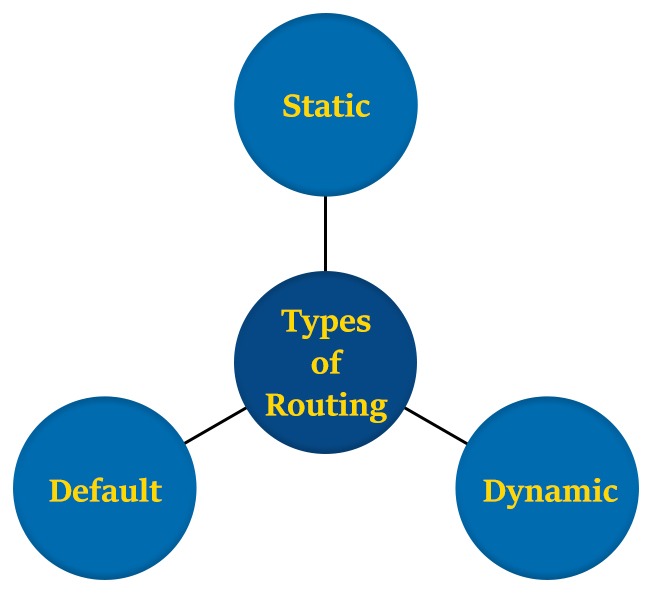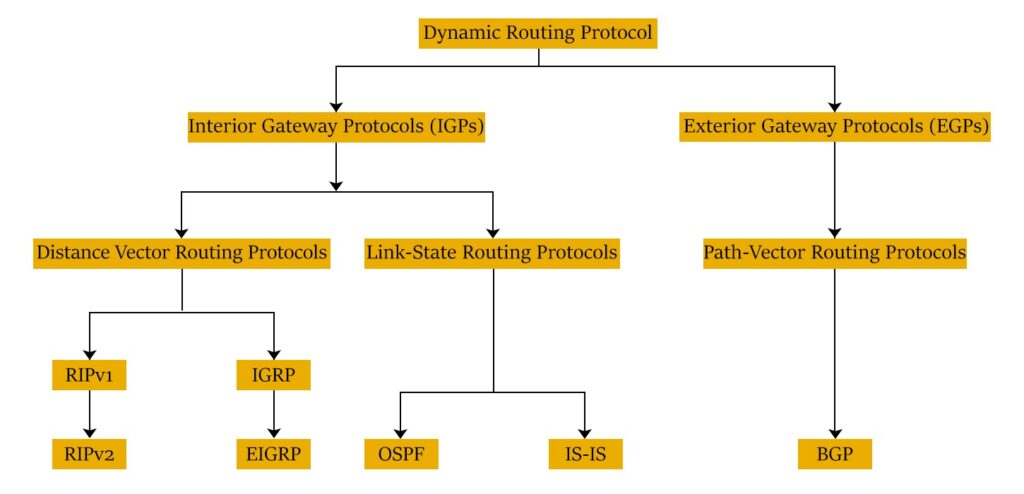Introduction
Routing is the process that determines the best path for data to travel across networks. It involves forwarding data packets from a source to a destination based on the destination’s IP address. To facilitate this process effectively, we use what are known as routing protocols. These protocols are the rules and conventions that dictate how routers communicate with each other to share information about network topology and reachability of destinations.
Understanding routing protocols is vital for networking professionals and anyone interested in how data travels across the internet. In this blog post, we will discuss what routing protocols are and understand different types of routing protocols.
Before discussing the different types of routing protocols, let us first understand what routing protocols really are.
What are Routing Protocols?
Routing protocols are integral to networks; they control the exchange of information between routers and decide the most suitable means to pass on information. These protocols help routers share information about the network state and the available routes to forward the data packets.
That is why each routing protocol has its own strategy for information collection and distribution. This is vital because the state of a network can change frequently due to various factors: devices can sometimes drop the connection, routing paths can disappear, or new paths can appear. Routing protocols assist various types of routers in getting the latest information to improve routing decisions on packets.
Routing protocol selection is dependent on the nature of a given network, including its configurations.
Now, let us discuss the various types of routing protocols and their uses.
Types Of Routing Protocols
There are several types of routing protocols, each designed to address different networking needs and environments. The main categories of routing protocols include Static Routing Protocol, Default Routing Protocol, and Dynamic Routing Protocol.

1. Static Routing Protocol
Static routing is where a network administrator configures the routes. This means that the data packets follow predetermined paths that are fixed and cannot be changed by anyone apart from the administrator. It is like trying to drive with a map that does not change even when you are in a different area.
Static routing is easy and requires little processing power — it is a good choice for small networks wherein the traffic pattern is unlikely to be updated frequently. Static routes can result in communication breakdowns or poor routing if, for instance, a link goes down or the network topology changes. In case any problem arises, it has to be solved by the network administrator, not by a given configuration; this might be a problem with large or complicated networks.
2. Default Routing Protocol
A default routing protocol is a simplified method of forwarding all the packets to a single exit point if the destination is unknown.
The default routing is most beneficial when used in stub networks, which refer to networks with only one possible route. In larger networks, it can be disadvantageous to set up a default route because data may be forwarded in the wrong path if there is no specific route available.
3. Dynamic Routing Protocol
These protocols use dynamic routing methods, which, in other words, means that the protocols change constantly according to the changing networking conditions.
Routers using dynamic protocols actively send information about route availability and its status to other routers. Such protocols can adapt to different network conditions that include network traffic, an increase in the number of devices in the network, or some devices in the network getting disconnected.
Dynamic routing can be thought of as a GPS system for your data: it always determines the most optimal routes to follow based on information that is real-time. This capability can help the networks stay at their peak performance regardless of the environment that surrounds them.
Dynamic protocol is further classified into a set of routing protocols. Let’s discuss all these protocols in detail.

Dynamic routing protocols are further classified into two main categories. These are:
3.1. Interior Gateway Protocols (IGP)
These protocols operate within a single organization or administrative domain. They manage routing within internal networks. Examples of IGP include distance vector routing protocols and link-state routing protocols.
Types of Interior Gateway Protocol (IGP)
3.1.1. Distance Vector Routing Protocols
These protocols are used to measure the distance of the destination in order to define the best path. Each router has its routing table with its immediate neighbors’ information to decide on the best route possible.
How It Works: Distance vector protocols are characterized by the sending of updates after regular intervals. Still, they give information about distance (generally in terms of hop count) to reach different network destinations. Afterwards, each router adjusts its routing table to its current status according to the information obtained.
Advantages: They are simple to implement and configure, making them suitable for small networks.
Disadvantages: They can consume more bandwidth due to constant updates and are slower to react to changes in the network.
Three popular distance vector routing protocols are:
- RIP (Routing Information Protocol): RIP is one of the oldest distance vector protocols. It uses the hop count as the metric to determine the best path. RIP is simple but not very scalable, making it suitable for small networks.
- RIPng (RIP Next Generation): An updated version of RIP designed for IPv6 networks.
- IGRP (Interior Gateway Routing Protocol): Developed by Cisco, IGRP uses a composite metric that includes factors like bandwidth, delay, and reliability. It is more complex than RIP but offers better performance.
- EIGRP (Enhanced Interior Gateway Routing Protocol): An advanced version of IGRP, EIGRP uses a diffusing update algorithm (DUAL) to find the best path. It is highly efficient and scalable, making it suitable for large networks.
3.1.2. Link-State Routing Protocols
These protocols maintain the entire network connectivity map, helping routers to make more informed decisions on routing. Routers with Link-state protocol send information only about directly connected links in the entire network to every other router.
How It Works: Every router forms a link-state packet (LSP) containing information about neighbors and the state of the links. This packet is then sent to all other routers, which makes it possible to develop the entire network map.
Advantages: They can quickly adapt to network changes and provide more efficient routing.
Disadvantages: Compared to distance vector routing protocols, link-state routing protocols have certain drawbacks, including increased configuration complexity, as well as higher memory and data processing requirements.
Two popular link-state routing protocols are:
- OSPF (Open Shortest Path First): It is one of the most popular link-state protocols today. It functions within an AS (Autonomous system). OSPF groups the networks hierarchically for better management and tracking.
- OSPF uses a cost-based metric based on link transmission speed and is, therefore, capable of selecting the least cost path.
- It supports large networks and is scalable because of the concept of layering, i.e., hierarchical structure.
- OSPF sends updates only when there is some change, so the bandwidth utilization is minimized.
- IS-IS (Intermediate System to Intermediate System): This protocol is very much like OSPF and it also uses a link-state technique. It was originally developed for local ISO networks but is now modified for Internet use.
- IS-IS is easier to utilize and can be used in IP as well as non-IP networks.
- On the same note, it optimized for large complex networks, though not as popular as OSPF.
3.2. Exterior Gateway Protocols (EGP)
These protocols are used for communication between two different organizations or between different administrative domains. They manage the flow of data between various networks. The most important example of the EGP is the border gateway protocol (BGP).
Types of Exterior Gateway Protocols (EGPs)
3.2.1. Path Vector Routing Protocols
Path Vector protocols keep track of the paths that data packets take from one node to the other in a network. This type is particularly suitable for interdomain routing (for example, in the case of multiple autonomous systems).
BGP (Border Gateway Protocol): BGP stands for Border Gateway Protocol and is used in the exchanging of information relating to routing between different networks. It finds out the optimal routes through which data can travel based on factors such as policies and characteristics of the path.
It heavily relies on “peers” or “neighbors” that assist in the exchange of routing information that further allows networks to address change or occurrence of outages in a real time.
- It is responsible for keeping a record of the path information dynamically with the changes in the network topologies.
- It makes use of attributes (AS-path or next hop) to regulate routing policies and to choose the best paths.
All the routing protocols we have discussed serve different or sometimes overlapping purposes. Understanding different types of routing protocols is crucial for selecting the right one based on your specific needs.
Frequently Asked Questions
Q1. What are the 3 types of routing protocols?
The three main types of routing protocols are:
- Static Routing Protocol
- Default Routing Protocol
- Dynamic Routing Protocol
Q2. What is routing and its protocol?
Routing is the process of directing data packets through a network. It uses various protocols like TCP/IP and OSPF to determine the best path for data to reach its destination.
Q3. What are layer 3 routing protocols?
Layer 3 protocols are the protocols that operate on layer 3 of the OSI model and are mainly responsible for determining the best path. Some examples of layer three protocols are RIP, OSPF, EIGRP, BGP, etc.
Q4. What is RIP, OSPF, and BGP?
RIP, OSPF, and BGP are routing protocols. OSPF and RIP are types of IGP (Interior gateway protocols), whereas BGP is a type of EGP (Exterior gateway protocols).
Q5. What are Switching Protocols?
Switching protocols are network protocols used to manage data traffic within a local area network (LAN) by efficiently forwarding data between devices. Common switching protocols include Spanning Tree Protocol (STP) to prevent loops, VLAN Trunking Protocol (VTP) for VLAN management, and Link Aggregation Control Protocol (LACP) for combining multiple links.
Conclusion
In conclusion, routing protocols play a crucial role in the efficient management of data transfer across networks. Understanding the various types, such as distance-vector, link-state, and path-vector protocols, is essential for network administrators to ensure optimal routing strategies. Each protocol offers unique advantages and is suited for different networking environments, whether it be a small local network or a vast wide-area network.





